THE SIMPLEST METHOD OF DETERMINING STREAM GUAGING " VELOCITY-AREA METHOD"
Source: HEPHZIBAH
Stream gauging is the process of measuring the water discharge or flow at a particular point on a stream or river. Measurement obtain from stream gauging are usually use for long study of ecological reason, preparing a data base for future purpose, studying trend for future growth. Stream gauging data is an indicator for community to forecast the potential impact of flow of water on drainage. data obtain from stream gauging is use to predict the potential flooding level of the river.
The discharge or flow rate can be estimated using
Velocity-Area method
Dilution gauging method
Control structure
Empirical formulae
RECONNAISSANCE SURVEY OF GAUGING SITE
A Reconnaissance survey is carried out to obtain information, historical properties and physical features of an area of study.
I #HEPHZIBAH is part of the group that carried out the project, The gauging site is a section of river osara flowing at kotopo area, camp road, Abeokuta, ogun state Nigeria. It is located at latitude 7.1862161 and longitude 3.43302694.Stream has bamboo vegetation on it bank and it is free from aquatic plant and floating debris.
The land area is relatively flat with a stable topography thereby making the channel relatively straight with a stable cross section. The velocity is greatest in the midstream near the surface and slowest near along the stream bed and banks due to friction. The flow of the river is laminar. This exercise was carried out on June 6th, 2017 at exactly 3:35 pm to 4:30 pm
**SITE SELECTION CRITERIA**
Selection of the measurement is a key factor in the stream flow measurement and has a large impact on the quality of the stream flow measurement.
The following criteria were followed
The stream stretch selected was reasonably straight
The flow in the cross section was laminar ( i.e. free of eddies, swirls, backward flow)
The cross section has a uniform, stable bed and free from large rocks, weed, sunken trees, and other obstruction that would create turbulence or interfere with the flow.
The direction of the stream flow was perpendicular to measure cross section
The stream cross section has a stable bed and is accessible at all times with the measuring equipment
The stream discharge is contained within the banks.
**STREAM GAUGING USING VELOCITY-AREA METHOD**
This method is based on continuity equation. The discharge Q in a stream with cross sectional area A and average velocity is calculated using this equation Q=AV where Q is discharge (m3/s), A is the cross sectional area of the stream (m2). Stream water velocity is measured using float method. To measure velocity via float method, one simply measured the time it takes for a floating object (such as orange, bag filled with water or any object which nullify the wind effect while moving with water current) to travel a measured distance. Velocity is calculated by dividing the distance travelled by the time it takes for it to travel that distance. Velocity also varies within the cross section of a stream, where the stream bank associated with greater friction and hence slower moving water.
Discharge is measured by multiplying the area and velocity of each point across the stream I.e. the stream is divided into section based on where velocity and stage height measurement were taken in the cross section of the stream. By multiplying the cross 3 sectional area by the velocity, one can calculate the discharge for that section of the stream. The discharge from each section can be added to determine the total discharge of water from the stream
Source: HEPHZIBAH
**MATERIAL/EQUIPMENT USED**
Pegs: These were used for selecting station
Rope: is used for the demarcation
Measuring tape: This is used to measure the length and width of gauging site and other demarcation and subsection
Mobile phone: this was used in place of stopwatch for timing and for obtaining the geographical coordinate of the gauging site using Google map
Ruler: for measuring small distance
Improvised float: material used for improvised float are three plastic bottle, rope, stick, super glue, 1 pair of bath room slippers, plastic roofing sheet
**METHOD USED IN IMPROVISING THE FLOAT**
Three plastic bottles were obtained and tied together with the rope, the Dunlop slippers which has been reshaped was placed on top of the plastic bottles and together with rope. A hole was made in the plastic roofing sheet, the stick was inserted into the hole that was made in the plastic roofing sheet which serve as the canister float to keep the float i.e. the three bottle submerged and was glued to the bathroom slippers.
**DESCRIPTION OF THE FLOAT**
Three 50cl plastic bottles were filled with water. Different volume of water was tried. When the bottle was fully filled with water and placed in the river, it became submerge and the pair of slippers helps in maintaining the balancing of the float.
The simplest method for determining a velocity of flow is by timing the movement of float over a known distance. Surface float is any floating objects which are often used in rough preliminary survey, these measurement only give the surface velocity and correction factor must be applied to give the average velocity over a depth. A factor of 0.7 is recommended for a river of 1m depth with a factor 0.8 for 6m or greater
Source: HEPHZIBAH
**GUAGING PROCEDURE**
A suitable gauging site was selected by measuring 15 meters along the river, after considering the site selection criteria.
The width of the river was then divided into four equal sections (each 0.7m wide) with measuring tapes, pegs, ropes, these tools were used to mark each section. This process was done by wadding.
The stage/depth of each section was obtained by inserting the improvised staff into the stream and then marking the water level. The water level on the improvised staff is now measured by the tape rule. This was done at different points within a section.
At the beginning of the section, a member of the group dropped the float in the stream at the designated starting point while time is taken for the float to get to its finish line by another group member.
Step (d) was repeated eight times
The average velocity was calculated by using the formulae
Va = Vf.C
Where Va is the average velocity, Vf is the flow velocity, C is the Co-efficient/Correction factor.
**COMPUTATIONAL PROCEDURE USING A FLOAT**
The depth of each segment was obtained.
Cross-sectional area of each segment was calculated by multiplying the segment depth by width using the equation below
Where A is the Cross-sectional area, B is the width, n is the segment number, d is the depth of the point.
Cross-sectional area of the whole section was obtained by summation of cross-sectional area of each segment.
Average travel time was calculated by dividing the summation of time taken by 8.
Velocity was calculated by dividing the distance travelled by the float by average time taken to move from upstream of the section to downstream of the section.
The discharge of the section was calculated by multiplying the average velocity by the cross-sectional area. (Q=Cross-sectional area X Average velocity).
NB : It was assumed that the float travelled along a straight path, neglecting slope effect on distance.
**MEASUREMENT AND ESTIMATION PRECAUTION.**
There are some precautions taken during stream gauging which are as follows
The river channel was swept clear of all obstacles and debris, causing obstruction, so as to prevent alternation of the flow rate.
Error due to parallax was avoided on the meter rule was avoided, to ensure accurate readings.
Readings and measurements of higher deviation from the previously measured and previous readings and measurements were taken again, to ensure precision.
Approximations were minimal during calculations involving derivation or estimation of parameters.
Source: HEPHZIBAH
CONCLUSION
The rate of flow of the gauging site along river osara, Kotopo, area, at Camp, in Abeokuta, Ogun State using Velocity Area method via a float. The flow rate obtained using a float at our gauging station with length of 15m and width of 2.8m having the cross sectional area and flow velocity 0.5915 m2 and 0.34 m/s respectively is 0.201m3/s.
The velocity and discharge is low which does not pose threat to the public health. But if there is heavy rainfall there is possibility of flooding because the river Banks Is susceptible to water-logging. Stream gauging data allow the community to forecast the potential effect of future water flow on the local water shed for future project.
**REFERENCES**
Angel Coswell. (July 2015). How to calculate stream flow rate.
CEE 370 Lab exercise. (2016). Measuring stream flow.
Dr Greg perzyna. (November 2016). Field manual. Current meter stream flow measurement by wading.
IEIA. Flow discharge using the float method.
Joy P, Michaud, Marlies Wierenga. (July 2015). Estimating discharge stream flow.
Pariva Dobriyal, Ruchi Badola, Chongpi Tubor, Syed Ainul Hussain. (October 2016) A review of method for monitoring stream flow for sustainable water resources management.
www.google.com
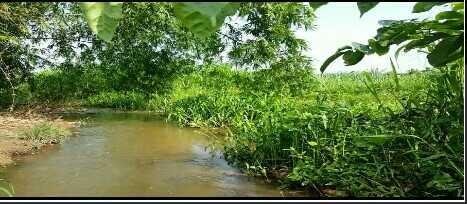
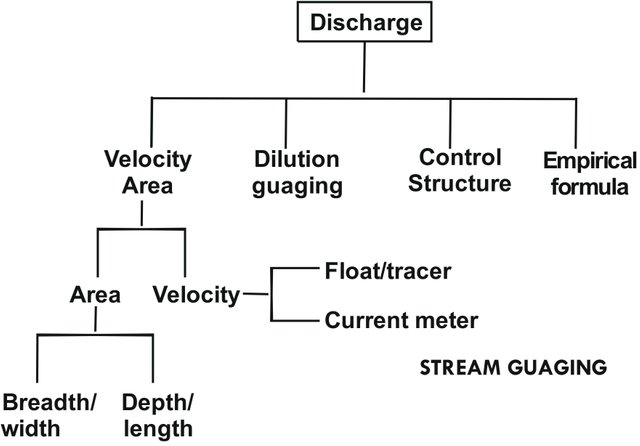
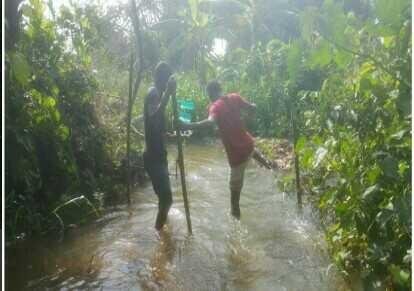
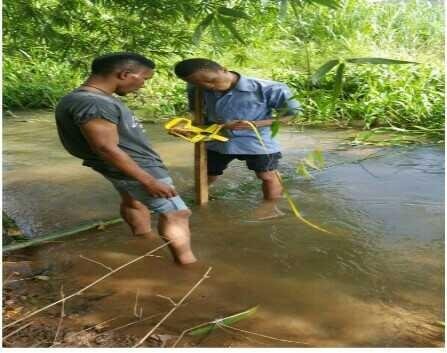
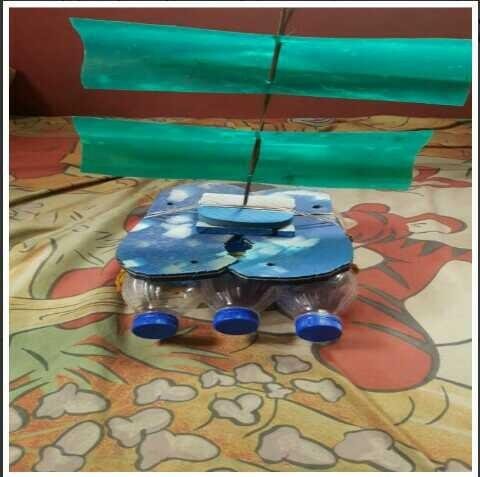
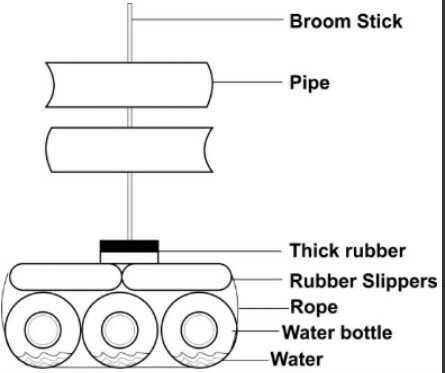
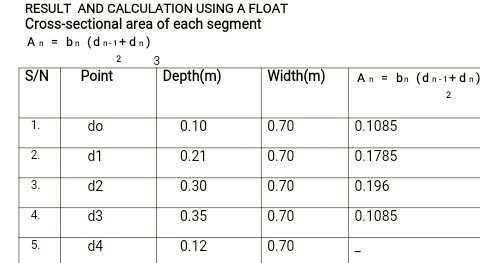
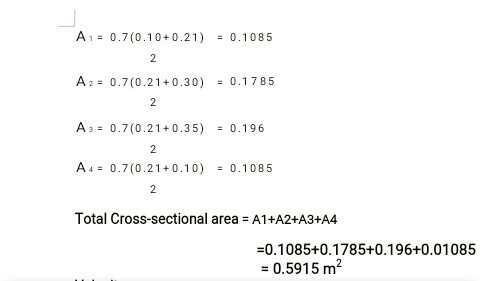
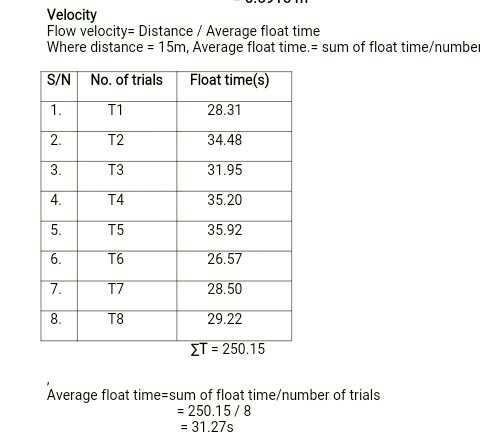
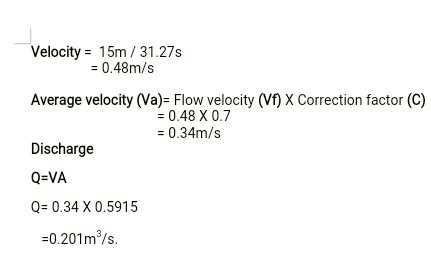
Yes
You have been upvoted by @black-man because I found your content useful. I run the Yensesa.com project @yensesa , which is the first Ghanaian Steem/SBD to fiat exchange in Ghana using mobile money. We also use our steem delegations to support and promote quality post of new members.
== You can delegate to help us promote Steem and support new members ==
REPLACE username with your username (no @ symbol)
50 SP = 103470.397100
https://v2.steemconnect.com/sign/delegateVestingShares?delegator=username&delegatee=yensesa&vesting_shares=103470.397100%20VESTS
100 SP = 206940.794200
https://v2.steemconnect.com/sign/delegateVestingShares?delegator=username&delegatee=yensesa&vesting_shares=206940.794200%20VESTS
250 SP = 517351.985500
https://v2.steemconnect.com/sign/delegateVestingShares?delegator=username&delegatee=yensesa&vesting_shares=517351.985500%20VESTS
500 SP = 1034703.971000
https://v2.steemconnect.com/sign/delegateVestingShares?delegator=username&delegatee=yensesa&vesting_shares=1034703.971000%20VESTS
1000 SP = 2069407.942000
https://v2.steemconnect.com/sign/delegateVestingShares?delegator=username&delegatee=yensesa&vesting_shares=2069407.942000%20VESTS
This is a satisfactory write up to me. The project carried out was nice but I feel you have not reported it well.
First, your title suggested that you were going to discuss various techniques of measuring flow but you only discussed one method - velocity -area method. You should have had the title pointing to this specific technique and then in the body of the article you can let us know that other methods could be used.
Also your formatting is not attractive. Most of your headings were not bold enough. You could have pulled some images to the right or left and center some. You should have also broken large body of texts into smaller ones and also space separate paragraphs.
I personally understand what you discussed but that is because I am learned in this area. However I can not say the same for someone who doesn't really know much about this aspect.
If you need assistance you can join the SteemSTEM Discord server here:https://discord.gg/vwzWz3Z to get someone to mentor you.
You can also message me privately. My discord name is the same as on Steemit.
Best wishes!
Congratulations @hephzibah01! You received a personal award!
You can view your badges on your Steem Board and compare to others on the Steem Ranking
Do not miss the last post from @steemitboard:
Vote for @Steemitboard as a witness to get one more award and increased upvotes!